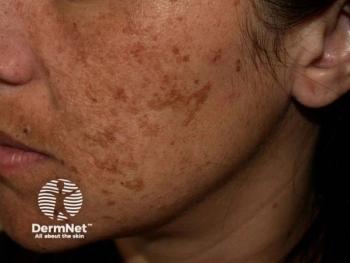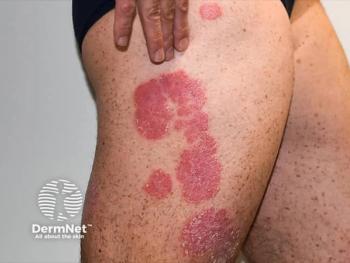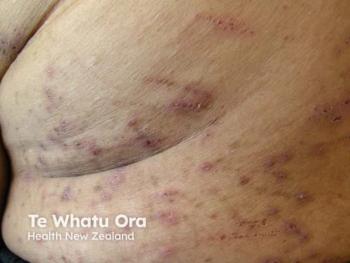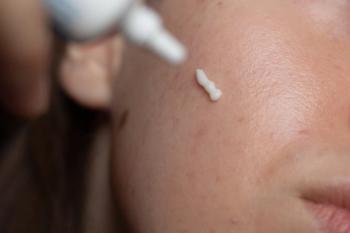
Gene Expression Profile Testing Offers Clinicians a Path to Safely Avoid SLNB in Low-Risk Melanoma Patients
Key Takeaways
- The DecisionDx-Melanoma test improves prognostic accuracy, helping clinicians identify patients who can safely avoid SLNB, reducing unnecessary procedures and associated risks.
- The DECIDE study validates the test's clinical utility, showing it accurately predicts sentinel node positivity risk, supporting its integration into clinical practice.
New prospective data from the DECIDE study reinforce the role of the 31-GEP test in clinical decision-making.
A new analysis from the prospective, multicenter DECIDE study, recently
To better understand the real-world implications of this study and how it may impact melanoma care, Dermatology Times spoke with surgical oncologist J. Michael Guenther, MD, lead author of the study, and Matthew Goldberg, MD, senior vice president, medical at
The Evolving Landscape of Melanoma Care
Guenther, a long-time adopter of Castle Biosciences’
"I first became aware of Castle's product about 10 years ago, and it’s been a labor of love since," Guenther shared. "The more I've gotten involved in using it and helping develop it, the more uses we've seen. I'm certainly a better physician from my use of this both for my own family and as well as for my patients."
The DecisionDx-Melanoma test, which assesses gene expression in cutaneous melanoma, offers a nuanced approach to risk assessment, helping clinicians determine which patients can safely forgo SLNB. Guenther emphasized that only about 12% of patients undergoing SLNB actually have positive nodes, highlighting the need for a more selective approach.
Improving Risk Stratification with Genetic Profiling
The core value of the DecisionDx-Melanoma test lies in its ability to improve prognostic accuracy beyond traditional clinical and pathological factors like Breslow depth and ulceration status.
Goldberg, a dermatologist and dermatopathologist, explained the test’s role in melanoma diagnosis.
"Dermatologists are really at the forefront of melanoma diagnosis," Goldberg noted, emphasizing the need for refined risk stratification in clinical practice. "I think that for me, the strategic vision of the DecisionDx-Melanoma test is essentially to refine the prognostic accuracy for patients diagnosed with cutaneous melanoma. What this means is: Can we do better as a subspecialty, as clinicians, in risk stratifying our patients who are diagnosed with this impactful cancer beyond the clinical and pathologic factors that we have access to at the time of diagnosis?"
The DecisionDx-Melanoma test is designed to refine prognostic accuracy, particularly in patients whose risk for positive SLNB falls between 5% and 10%.
"The test helps us discern patients in that risk range more clearly, providing valuable data to guide management decisions," Goldberg said. By integrating molecular data with clinical factors, the test aids in more informed, individualized decision-making.
DECIDE Study and Clinical Validation
The prospective multi-center DECIDE trial provides pivotal evidence supporting the clinical utility of the DecisionDx-Melanoma test. The newly-published results demonstrates that the test accurately predicts sentinel node positivity risk, offering significant implications for clinical practice.
Goldberg emphasized, "The test can accurately identify patients who have a less than 5% risk of having a positive sentinel lymph node biopsy at the time of diagnosis, who can be counseled about that risk."
Guenther echoed these findings, highlighting the test's robustness across diverse populations and clinical settings.
"It doesn’t matter where it’s done or on which population it’s used on, it still gets the same results," he noted. This robustness has helped establish the test as a valuable tool in reducing unnecessary biopsies and improving patient outcomes.
Streamlining Clinical Decision-Making
From a practical standpoint, integrating the DecisionDx-Melanoma test into clinical workflows has become increasingly streamlined. Guenther shared that the test results are typically available within 4 to 5 working days after a melanoma sample is received, making it a rapid and efficient addition to the care pathway. He also pointed out that dermatologists, who are often the first to identify melanomas, have embraced the test.
However, despite its proven benefits, some clinicians remain hesitant due to traditional reliance on established guidelines or skepticism about newer methodologies.
"It took a while to overcome resistance to the way we always did things," Guenther admitted. "But I think the data speaks for itself. It's now more a question of adaptation and use in clinical practice to make it easy. However, I think the DECIDE study, the way we did that, is almost a perfect template for how this works in clinical practice."
Clinical and Economic Impact
Both Guenther and Goldberg agreed on the broader implications of the DecisionDx-Melanoma test, particularly in terms of reducing unnecessary surgeries and associated costs.
"The less unnecessary surgery we do, the better," Guenther emphasized, noting the substantial cost savings and reduced morbidity associated with avoiding unnecessary SLNBs.
Looking Ahead: Future Research and Advancements
As the clinical utility of DecisionDx-Melanoma continues to grow, both experts remain invested in ongoing research, particularly the long-term outcomes in low-risk patients and the integration of clinical-pathological data.
Goldberg also sees DecisionDx-Melanoma as part of a larger movement toward precision medicine in oncology.
"I think this is an exciting moment for precision medicine," Goldberg said. "This [is a] moment of personalized medicine or precision medicine, where, to me, the challenge is: Can we do better than our histopathologic correlates? Can we do better than staging to refine our engine of prognosis for the benefit of the patients that we care for in the clinic?"
Guenther expressed his enthusiasm for future studies, saying, "The DECIDE study with an integrated result will give us far more expansive results than what we already have. Studies are cool, but I can't wait to see where that leads us, because I think it will give us even more information that this has just started to roof."
Reference
- Guenther JM, Ward A, Martin BJ, et al. A prospective, multicenter analysis of recurrence-free survival after sentinel lymph node biopsy decisions influenced by the 31-GEP. Cancer Med. Published online April 1, 2025.
doi:10.1002/cam4.70839
Newsletter
Like what you’re reading? Subscribe to Dermatology Times for weekly updates on therapies, innovations, and real-world practice tips.


















